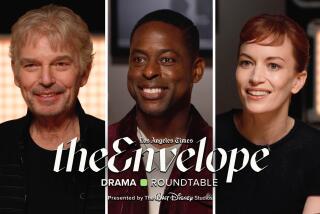Book review: ‘Angelina’ by Andrew Morton
- Share via
For months, Angelina Jolie’s face has been looking out from billboards alongside a single question: “Who is Salt?”
The tagline refers to the new thriller, “Salt,” about a CIA agent suspected of being a Russian spy (the movie has an identity crisis of its own, the main character was originally cast as a male). But the genius in the marketing, of course, is that we’re asking the same thing about the actress herself.
Enter “Angelina,” the unauthorized biography by Andrew Morton, who has penned celebrity biographies of Tom Cruise, Monica Lewinsky and Princess Diana. Morton’s “Salt” is a 35-year-old, second-generation Hollywood actor who has spent her entire life in the public eye, careening through a crazy-quilt of rumor, truth and half-truth regarding (in no particular order or veracity) a fascination with death, heroin use, bisexuality, the serial inking of skin, the bedding of other women’s men, the winning of an Academy Award, a U.N. goodwill ambassadorship and the top spot of Forbes’ 2009 “Celebrity 100” list … not to mention having a family of six children with Brad Pitt.
If there is a celebrity today who merits the spadework of an unauthorized Morton biography, it’s Jolie, with a potential audience that includes just about anyone who has gone through a supermarket checkout line in the last decade, glanced at tabloid headlines about Angelina, say, open- mouth kissing her brother or swapping vials of blood with Billy Bob Thornton and wondered: “What was she thinking?”
Morton’s “Angelina” can’t answer for sure — none of the principal players in the tale, which begins in 1950 with the birth of her mother Marcia Lynne Bertrand and ends earlier this year with her charity work in Haiti, appear to have cooperated with him. Among his most relied-upon, on-the-record sources seem to be a former babysitter of the Voight children and Angelina’s alleged one-time drug dealer — but Morton manages to advance a plausible theory nonetheless.
First off, as Morton points out early on (and reminds us frequently), Angelina Jolie Voight, born on June 4, 1975, is a Gemini — complete with all the light/dark, good/bad, impulsive/reflective duality that the astrological sign entails. But, since the world is home to plenty of Geminis who haven’t inked Thornton’s name below their bikini line on a whim, there’s clearly more at work.
So, in recounting her story, Morton turns to professional psychologists (who he’s careful to point out have never counseled the actress) to offer their opinions. By applying that armchair psychology to the version of events he’s patched together, Morton presents a surprisingly sympathetic portrait of a woman with abandonment issues, extreme impulsivity and a knack for leveraging the endless media hunger for every last morsel of celebrity tidbits in a way that allows her to continually cast, craft and recraft her image.
If there’s anyone to blame here, according to this book, it’s the parents, since the bitter relationship between actor Jon Voight and Marcia Lynne (later Marcheline) Bertrand runs as a subplot throughout. Her father left Bertrand for another woman when Angelina was 2, and her mother/manager is portrayed as vacillating between being a laissez-faire hippie mother and a pushy sort of stage mom who, according to Morton, tried — among other things — to push her daughter into a relationship with Mick Jagger.
The book also reports, in addition to two marriages — first to actor Jonny Lee Miller and later to Thornton (who happened to be engaged to Laura Dern at the time) — Jolie’s pursuit by a besotted Timothy Hutton, a near-romantic encounter with Gary Sinise and a relationship with model Jenny Shimizu. And then there’s the fireball of fame that is “Brangelina” — which Morton suggests was at least sparked, if not fully kindled, while Pitt was married to “Friends” star Jennifer Aniston. (Morton, who knows his way around a nuance, implies with as much certainty as he can muster that they were fully engulfed early on.)
It’s at this point that the book seems to move into hyperdrive, with endless rounds of globe-trotting, location shooting, child-acquiring and philanthropic efforts. But the faster it seems to move, the harder it is to put down. Maybe that’s because, like salt, we have a craving for explanation, for back story, and Morton’s book offers a satisfying dose of both. While the healthier approach might be to limit the intake by vowing to pick it up occasionally and flip to the index for a snippet like: “Haven, James…relationship with” or “ United Nations High Commissioner for Refugees,” that’s not likely to happen.
No matter how bad it might be for you, chances are you won’t be able to put this book down until your mouth is dry and your blood pressure is racing.
adam.tschorn@latimes.com
More to Read
Sign up for our Book Club newsletter
Get the latest news, events and more from the Los Angeles Times Book Club, and help us get L.A. reading and talking.
You may occasionally receive promotional content from the Los Angeles Times.











